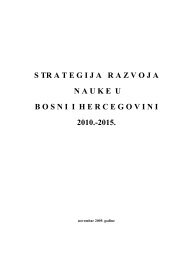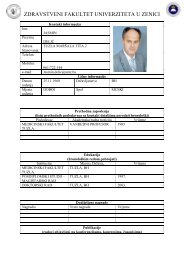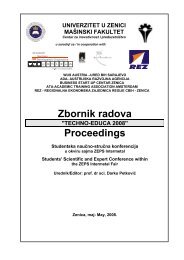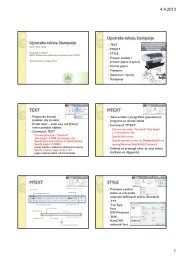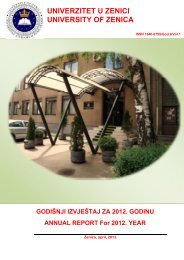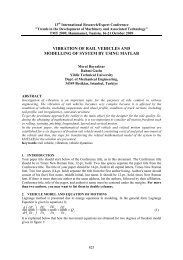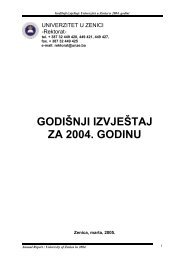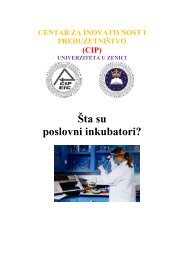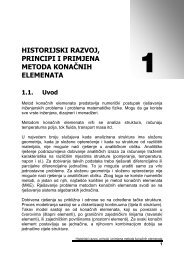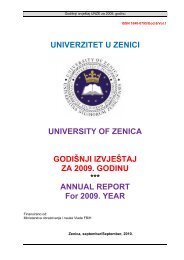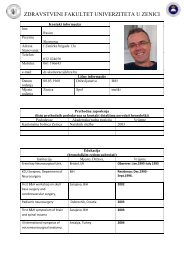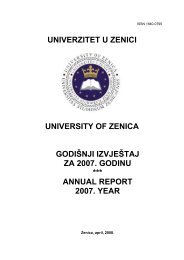structure of az31 magnesium alloy after ecap processing
structure of az31 magnesium alloy after ecap processing
structure of az31 magnesium alloy after ecap processing
Create successful ePaper yourself
Turn your PDF publications into a flip-book with our unique Google optimized e-Paper software.
other one for heat treatment and for metallographic analysis. The remaining parts were cut and milledto the specimens with dimensions 15 x 15 – 60 mmfor use at experiments on theECAP equipment.Figure 3. Geometry <strong>of</strong> specimens3.1. Stress – strain curvesAccording to the assumptions the increase deformable resistance occurs in all the instruments <strong>of</strong>ECAP with the increasing number <strong>of</strong> passes. Selected readings <strong>of</strong> stress-strain curves <strong>after</strong> selectedpasses through the channel for <strong>magnesium</strong> <strong>alloy</strong> AZ31 is shown in Fig. 4. Experiments wereperformed at the temperature <strong>of</strong> 220° C. Very good results were achieved using tools geometry withembedded helix <strong>after</strong> the 1 st and 5 th passes through the ECAP tool.Figure 4. The stress – strain curves <strong>of</strong> <strong>magnesium</strong> <strong>alloy</strong> AZ313.2. Measurement <strong>of</strong> distribution <strong>of</strong> hardnessThe specimens for measurement <strong>of</strong> distribution <strong>of</strong> hardness in initial state <strong>of</strong> material were taken fromthe supplied blanks. The taken specimen has the shape <strong>of</strong> semi-circle and a mesh was plotted on it forrealisation <strong>of</strong> indents. Diagram <strong>of</strong> the mesh design and its realisation is shown in Fig. 5. Dimension <strong>of</strong>each mesh segment was 5 mm.Figure 5. Example <strong>of</strong> layout <strong>of</strong> the mesh <strong>of</strong> evaluated points on the specimen for determination <strong>of</strong>hardnessAverage hardness <strong>of</strong> the initial state <strong>of</strong> the <strong>alloy</strong> AZ31 was 55.984 HV5. In the initial material for theECAP process produced by casting with subsequent extrusion a considerable heterogeneity wasdetermined, which was manifested in the obtained values <strong>of</strong> hardness. After 4 th passes through theECAP tool the average value <strong>of</strong> hardness 69.206 HV5 was achieved. Hardness increased approx. by30%.53
3.3. Metallographic analysisa b) c)Figure 6. Structure <strong>of</strong> the <strong>alloy</strong> AZ31_a) initial state, b) specimen edge ( magnification 200),c) <strong>after</strong> 3 rd pass (magnification 1000)It is possible to assume from the analysis <strong>of</strong> initial states <strong>of</strong> the <strong>alloy</strong> AZ31 (see Figs. 6) that <strong>structure</strong>sare formed by irregular grains <strong>of</strong> solid solutions <strong>of</strong> tramp elements dissolved in <strong>magnesium</strong> matrix. Incomparison with the initial state we may observe substantial grain refinement, including their moreuniform size. This has unequivocally proved the efficiency <strong>of</strong> the new geometry <strong>of</strong> the ECAP toolfrom the viewpoint <strong>of</strong> substantial grain refinement. During the next stage <strong>of</strong> experimental workstensile tests will be performed on short specimens for verification <strong>of</strong> the obtained results – influence <strong>of</strong><strong>structure</strong> refinement on enhancement <strong>of</strong> mechanical properties.4. CONCLUSIONSIt may be stated on the basis <strong>of</strong> the obtained results that the new geometry <strong>of</strong> the ECAP tool hasconsiderable influence <strong>of</strong> efficiency <strong>of</strong> the grain refinement process. It follows from metallographicanalysis that substantial <strong>structure</strong> refinement takes place already <strong>after</strong> the 2 nd and 3 rd passes. Due to thefact that the semi-products used for specimens showed already considerable heterogeneity (accordingto measurement <strong>of</strong> hardness). It will be necessary to achieve in future a very good homogeneity for thesubsequent ECAP process. Future works will also verify influence <strong>of</strong> lower temperature onstrengthening and final <strong>structure</strong>.5. ACKNOWLEDGMENTSThe authors would like to acknowledge gratefully the Ministry <strong>of</strong> Education, Youth and sports <strong>of</strong>Czech Republic for its support to the project “Creation <strong>of</strong> an international team <strong>of</strong> scientist andparticipation in scientific networks in the sphere <strong>of</strong> nanotechnology and unconventional formingmetal”, CZ.1.07/2.3.00/20.0038.6. REFERENCES[1] Morishige, T., Hirata, T., Uesugi, T., Takigawa, Y.,Tsujikawa, M. and Higasia, K.: Effect <strong>of</strong> Mg content onthe minimum grain size <strong>of</strong> Al-Mg <strong>alloy</strong>s obtained by friction stir <strong>processing</strong>, Scripta Materialia, 64 (2011),p. 355-358[2] Yanga, Y.Q., Lia, B.C. and Zhanga, Z.M.: Flow stress <strong>of</strong> wrought <strong>magnesium</strong> <strong>alloy</strong>s during hotcompression deformation at high temperatures, Materials Science and Engineering: A, vol. 499, Issues 1-2,2009, p.238-241[3] Hadasik E., Kuc D. and Mikuszewski T.: Plasticity and micro<strong>structure</strong> <strong>of</strong> Mg-Li <strong>alloy</strong>, Metallurgy-News,78, 8. 2011, p.617-621[4] Varyukhin, V., Beygelzimer, Y., Kulagin, R., Prok<strong>of</strong>'eva, O. and Reshetov, A. Twist Extrusion:Fundamentals and Applications, Materials Science Forum 2-vol. set, Vols. 667-669 (2011), ISSN 0255-5476, p. 31-38[5] Duan, Z. C. and Langdon, T. G. Effect <strong>of</strong> a Special ECAP Die Configuration on MicrohardnessDistributions in Pure Aluminum, Materials Science Forum 2-vol. set, Vols. 667-669 (2011), ISSN 0255-5476, p. 69-74[6] Zhilyaev, A. P., Langdon, T., G. Progress in Materials Science, 53 (2008), p. 893–97954



